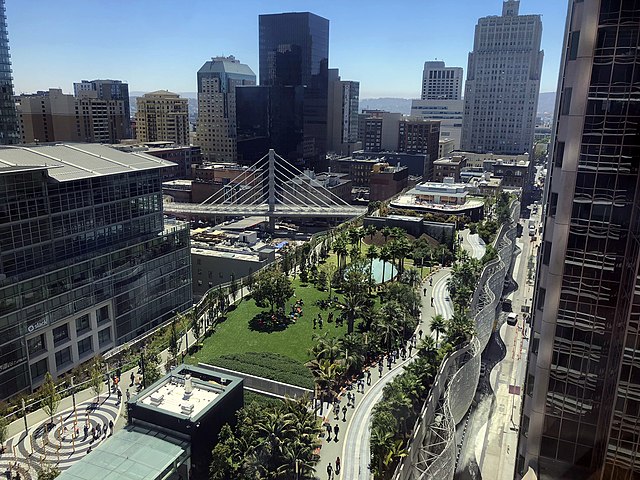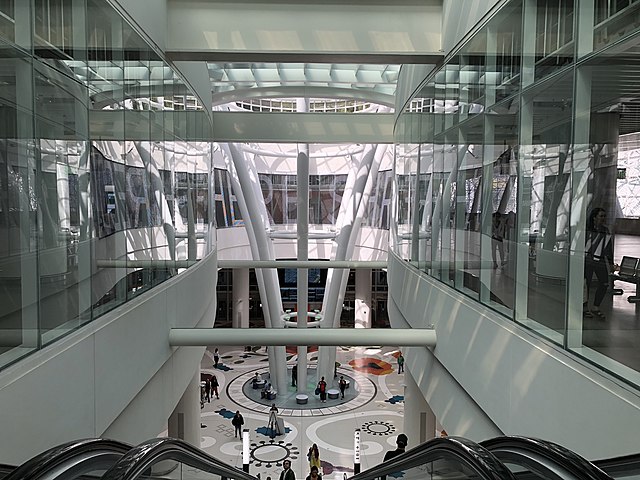 The new Salesforce Transit Center in San Francisco features a 5-acre rooftop park, an example of the innovative way cities are now creating green spaces. (Photo by Fullmetal2887
The new Salesforce Transit Center in San Francisco features a 5-acre rooftop park, an example of the innovative way cities are now creating green spaces. (Photo by Fullmetal2887
When a city builds a giant structure, a new bus terminal for example, why not put some grass, park benches and shrubbery on the roof and create a park too?
That's exactly what the City of San Francisco did recently when they opened their new Salesforce Transit Center and added a huge rooftop park.
The innovative 5-acre park is already creating a buzz not just around town, but around the nation as well.
The Salesforce Transit Center is a monstrous structure, almost the length of five football fields, that people are now calling the "Grand Central Station of the West."
Construction of the terminal began back in 2010 and was instigated by the 1989 Loa Prietra earthquake, which damaged the previous Transbay Terminal that had served as the bus depot since 1939. Total cost will be an estimated $2.26 billion.
The building is located right in the heart of downtown San Francisco. Currently the structure only accommodates buses and bus passengers. There are future plans to add an underground rail station to hook up with Caltrain and the new California High-Speed Rail which will run through the state.
But this is way more than a bus station.
The project is more than one million square feet and covers five levels - two below ground and three above.
There is a central grand hall (hence the comparison to the popular New York train station) and 100,000 sq. feet for retail and restaurants. The interior spaces are very cool and filled with public art such as unique lighting, gardens and a LED sign that are integrated into the architecture.
 Interior of Salesforce Transit Center which some people are calling the "Grand Central Station of the West." (Photo by Fullmetal2887)
Interior of Salesforce Transit Center which some people are calling the "Grand Central Station of the West." (Photo by Fullmetal2887)
But what's really catching people's attention is up above, on top of the structure. Rather than just waste all that space with tarpaper and air conditioning units, the designers added the enormous park.
The park runs the entire length of the structure, nearly four blocks. There are 600 trees and 16,000 plants featured in more than a dozen botanical showcase areas.
There are plenty of park benches to enjoy the scenery. And curved walkways/jogging paths for strolling. But the designers didn't stop there. The park also features an amphitheater for events, grassy lawns for relaxing and dancing fountains for children to play around. Yes, that's right - dancing fountains. Called "Bus Jet Fountain" the installation created by Ned Kahn consists of water jets that shoot up from the park deck and are coordinated with the movement of buses below.
In essence, this bus terminal is home to a brand-new "urban park in the sky." In a city such as San Francisco where space is expensive and limited, it is truly amazing to be able to add a new park for the public that is nearly four blocks long.
The rooftop park was designed by PWP Landscape Architecture.
Overseeing the park will be the urban planning consulting firm, Biederman Redevelopment Ventures. They will manage the park's events, marketing and revenue.
The firm reportedly has plans for everything from yoga classes to cultural events to movies, chess tournaments, reading rooms, art shows, children's activities and concerts.
"Our vision of the rooftop park at the Salesforce Transit Center is an elevated urban oasis that offers the visitor experiences unlike any other public space in San Francisco," said Dan Biederman, president of the company. "We aim to make the park an asset for the entire downtown and South of Market community, as well as a destination for people throughout the Bay Area."
BRV has a successful track record managing parks around the US, including the Bryant Park project. That space was once known as a high-crime area called "Needle Park" but has since been transformed to a vibrant and very popular public space.
On their website, the company states: "Great public spaces are critical to revitalizing neighborhoods, increasing property value and improving safety."
The Salesforce Transit Center Park is being compared to the successful High Line park in New York City that is 1.45 miles long and built on an abandoned rail line. That park is a success story known world-wide and attracts some 5 million visitors annually.
In addition, the High Line park has spurred an incredible amount of development in the area surrounding the project, raising property values and generating more tax revenue.
The Salesforce Transit Center is following suit. Thirteen towers have been built or are planned for property nearby. The largest is the city's new tallest building, Salesforce Tower, home to the popular software company of the same name. (As you might have noticed, the transit hub is also named Salesforce. That's because the company paid $110 million for the naming rights. Not a bad way to help offset the enormous cost of adding this wonderful new building and green space to the city).
This is a great trend to see.
The movement where developers include green space in major urban projects. Experts predict more and more people will be moving to urban areas in the future. Ironically, that means providing green, open spaces for them will be more difficult than ever.
Here's an alternative. Go up. Just like the High Line took an elevated rail line and transformed it into a destination site for citizens and tourists, we're sure the Salesforce Transit Center park will attract an enormous number of visitors. Those visitors will frequent the park, events and the retail shops and restaurants to help generate funds for the project.
Secondly, hopefully, city officials are seeing green spaces as a revenue-generator, not a cost. The High Line sparked a building boom in surrounding neighborhoods. The NY Times put the economic impact at $2 billion. The same is happening with the Salesforce Transit Park.
We hope to see more of this taking place. And it is.
The proposed Underline park in Miami will use space under the Metrorail line to build a series of connected "linear" parks stretching 10 miles throughout the city. That exciting project will include not only park benches and bike trails, but will feature works of art as well.
In Atlanta, the city and the Atlanta BeltLine have purchased the final segment of an inactive rail line for a 22-mile Beltline park project. Portions of that park already function as a multi-use trail.
Folks, you are seeing the new face of parks in urban America.
The attention these success stories are receiving is certainly encouraging and gives hope to the future for more green spaces to be added, not reduced, in our growing cities.


